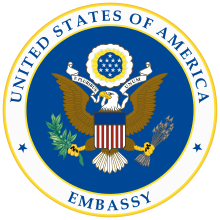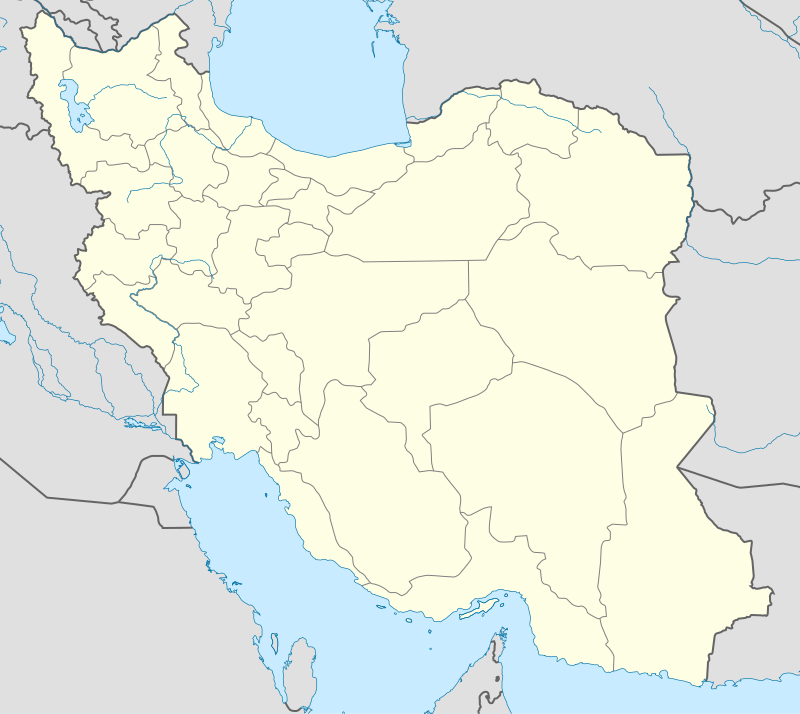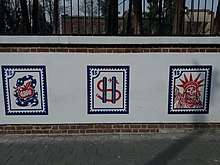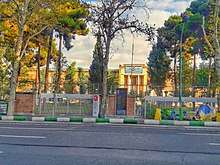Embassy of the United States, Tehran
The Embassy of the United States of America in Tehran was the United States of America's diplomatic mission in the Imperial State of Iran. Direct bilateral diplomatic relations between the two governments were severed following the Iranian Revolution in 1979, and the subsequent seizure of the embassy in November 1979.[1][2]
| Embassy of the United States, Tehran | |
|---|---|
| Native name Persian: سفارت ایالات متحده آمریکا، تهران | |
 Defaced Great Seal of the United States | |
| Location | |
| Coordinates | 35.708°N 51.424°E |
| Opened | 1951 |
| Closed | 1979 |
| Ambassador | Loy W. Henderson (first) Bruce Laingen (last) |
 Location of Embassy of the United States, Tehran in Iran | |

History

The embassy was designed in 1948 by the architect Ides van der Gracht, the designer of the Embassy of the United States in Ankara. It was a long, low two-story brick building, similar to American high schools built in the 1930s and 1940s. For this reason, the building was nicknamed "Henderson High" by the embassy staff, referring to Loy W. Henderson, who became America's ambassador to Iran just after construction was completed in 1951.[3]
The US diplomatic mission has been defunct and the building has not been used by the U.S. since the Iran hostage crisis of 1979.[1][2] Since then, the United States government has been represented in Iran by the United States Interests Section of the Embassy of Switzerland in Tehran.[4] The name currently given to the compound by many Iranians is variously translated as "espionage den," "den of espionage", and "nest of spies".[5][6]
After the fall of the embassy, the Revolutionary Guard used it as a training center, and continue to maintain the complex.[7] The brick walls that form the perimeter (the embassy grounds are the size of a city block) feature a number of anti-American murals commissioned by the government of Iran.[7] The site has also housed a bookstore and a museum[8]). Part of the embassy has been turned into an anti-American museum, and several student organizations maintain offices in the former embassy complex.[9] As of January 2017, the site is open to the Iranian public and foreigners. The Great Seal of the United States is badly damaged, but still visible at the entryway.
The Muslim Student Followers of the Imam's Line published documents seized in the embassy (including painstakingly reconstructed shredded documents) in a series of books called "Documents from the US Espionage Den" (Persian: اسناد لانه جاسوس امریكا, Asnād-e lāneh-e jasusi Amrikā).[10] These books included telegrams, correspondence, and reports from the United States Department of State and Central Intelligence Agency, some of which remain classified to this day.
U.S. Interests Section of the Swiss Embassy
When diplomatic relations were broken, the United States appointed Switzerland to be its protecting power in Iran. Informal relations are carried out through the United States Interests Section of the Swiss Embassy. Services for American citizens are limited. The section is not authorized to perform any U.S. visa/green card/immigration-related services.[9]
In February 2009, the Iranian police arrested Marco Kämpf, the Swiss diplomat acting as the First Secretary of the US Interests, after finding him with an Iranian woman in a car. He was immediately recalled to Switzerland.[11][12]
Former Iranian Embassy in Washington, D.C.
The U.S. State Department seized the former Iranian Embassy in Washington, D.C. in retaliation for the seizure of the U.S. Embassy in Tehran. The Iranian Interests Section operates out of the Pakistani Embassy.[13][14]
See also
References
| Wikimedia Commons has media related to Embassy of the United States in Tehran. |
| Wikisource has original text related to this article: |
- "Former American Embassy in Iran Attracts Pride and Dust". The New York Times. 2013-10-31.
- "Former U.S. Embassy in Iran: mistrust endures where hostages held". CNN. 2014-01-30.
- The architecture of diplomacy: building America's embassies ADST-DACOR diplomats and diplomacy series. Jane C. Loeffler. Publisher Princeton Architectural Press, 1998. ISBN 1-56898-138-4 p. 56
- Embassy of Switzerland in Iran – Foreign Interests Section, Swiss Federal Department of Foreign Affairs (page visited on 4 April 2015).
- Taubman, Philip (November 11, 2007). "In Death of Spy Satellite Program, Lofty Plans and Unrealistic Bids". The New York Times. Retrieved April 29, 2013.
- Federation of American Scientists on the Espionage Den
- "The Great Satan's Old Den: Visiting Tehran's U.S. Embassy". Time. 2009-07-14.
- Inside The Former US Embassy In Tehran, Iran
- Pleitgen, Fred (July 1, 2015). "Inside the former U.S. Embassy in Tehran". CNN.
- Documents from the U.S. Espionage Den
- "Swiss call diplomat home--but is there a scandal?". Iran Times International. Washington, DC. February 20, 2009.
- "Schweizer Diplomat nicht mehr im Iran tätig". 20 Minuten. 2009-02-09. Archived from the original on August 31, 2014. Retrieved December 29, 2016.
- Luxner, Larry (November 2001). "Despite Lack of Diplomatic Ties, Door to Iran is Slowly Opening". The Washington Diplomat. Archived from the original on 2011-09-09. Retrieved 2017-12-04.
The only difference is that the Cubans have their own office, which used to be the Cuban Embassy before their revolution. We don't have our own office, because the State Department has kept our embassy, and likewise, the Iranian government has the U.S. Embassy in Tehran.
- "Congressmen Pay A Visit to the Iranian Interest Section". The Weekly Standard. 4 February 2016.
Unlike the grand embassies of Washington, Pakistan's embassy is a nondescript brick building downtown that looks like it could house any number of commercial enterprises. Inside, the Iranian Interest Section has a cramped lobby underneath a staircase that keeps the rest of the Interest Section out of sight.
External links
- The Memory Hole at the Wayback Machine (archived May 13, 2010) hosts a gallery of photographs taken from inside the US Embassy during the crisis.
- The Memory Hole at the Wayback Machine (archived March 29, 2006) 400 Pages of Still-Classified CIA and State Dept Documents Seized From the US Embassy in Tehran.
- متن کامل و تحلیل اسناد لانه جاسوسی آمریکا (The Full Text and Analysis of the Documents from the US Espionage Den)
- Inside The Former US Embassy In Tehran, Iran
- Documents from the U.S. Espionage Den
- Contemporary photograph of the embassy gates (on flickr)
- Embassy of Switzerland - Foreign Interests Section
- U.S. Department of State page for Iran
- Virtual Embassy of the United States, Tehran (not a physical presence in Iran)